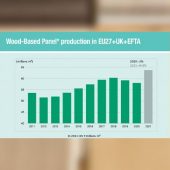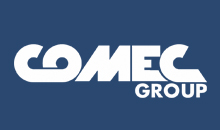The year 2022 had lights and shadows after a record year. This is the evidence of the figures released by Epf, the European federation of wood-based panel manufacturers, whose annual report indicates that production decreased by 8 compared to 2021, falling just below 60 million cubic meters of panels (in 2021 it was 63.7 million).
Though lower than in 2021, these figures are in line with the federation’s expectations, especially in comparison to 2019 figures before the pandemic. The comparison of net production volumes is basically unvaried.
“Looking back to last year – said Martin Brettenthaler, Epf president, in the report introductory note – it is not surprising that the production volumes of federation members decreased by 7.8 percent in 2022 compared to the previous year. The most significant comparison must be made with 2019 and pre-crisis levels. This comparison is very different, revealing a 0.4 percent reduction”.

Martin Brettenthaler
Besides real production, also apparent consumption decreased sharply, down to 60.8 million cubic meters (minus 7 percent versus 2021), while the trade balance deficit (import-to-export ratio, editor’s note) literally boomed from 440 thousand cubic meters in 2021 to above one million in 2022.
The import flow of the trade balance was driven by the plywood segment, which compensated the export flow of particleboard, mdf, osb and fiberboard.
“Of course, shrinking production generates strong pressure on our industry. However – Brettenthaler said – as a result of the positive trend in the previous years, our industry is well prepared to overcome the current recession. So, the 7.8 percent reduction is a relatively encouraging result. Other sectors recorded much stronger decreases that will not always be recovered”.
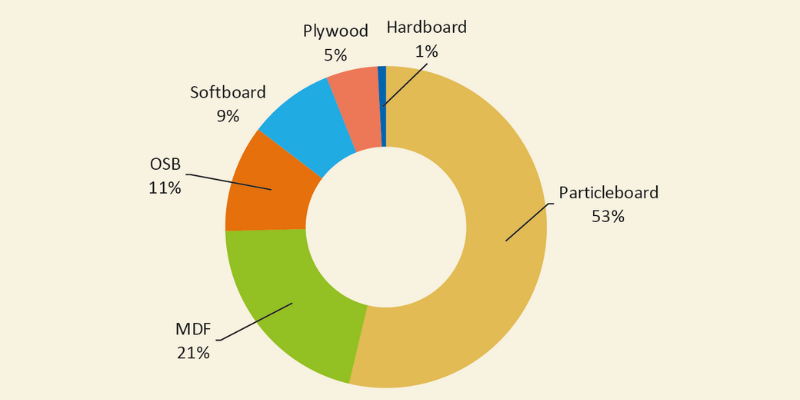
CHART 1 – Panels production shares
PARTICLEBOARD
The energy crisis in Europe caused the European production of particleboard in the Epf member countries to decrease by almost 7 percent in 2022. Production amounted to over 32.1 million cubic meters, close to pre-pandemic 2019 levels.
Germany is still the leading particleboard manufacturer in Europe with 5.5 million cubic meters in 2022, down by 8.9 percent from 2021. After overtaking France (3.16 million cubic meters) in 2019, Poland (3.8 million cubic meters) remains the second particleboard producer despite decreasing production (minus 9.6 percent), with Italy (2.75 million cubic meters) at number four.
Austria was the second producer of particleboard with a production of 2.29 million cubic meters (minus 10.4 percent).
Despite uncertain conditions, the European production of particleboard is expected to decrease by only 1.2 percent in 2023.
The top-five particleboard markets are the same as in the past five years: Germany, Poland, Italy, United Kingdom and France with an apparent consumption of 5.5 million cubic meters (minus 8.2 percent), 3.9 million cubic meters (minus 11 percent), 3.18 million cubic meters (minus 9.5 percent), 2.7 million cubic meters (minus 1.9 percent) e 2.7 million cubic meters (minus 11 percent).
Real demand increased significantly in Estonia (plus 23 percent), Croatia (plus 15 percent) and Bulgaria (plus 9.1 percent). Real consumption (minus 6.5 percent) decreased a bit more than apparent consumption (minus 6.3 percent) at 31.08 million cubic meters.
The furniture industry is the biggest user of particleboard in Europe. Constructions, including doors and floorings, accounted for 27 percent of total particleboard consumption, in line with 2021. The remaining one percent and five percent of particleboard consumption were absorbed by packaging and other applications.
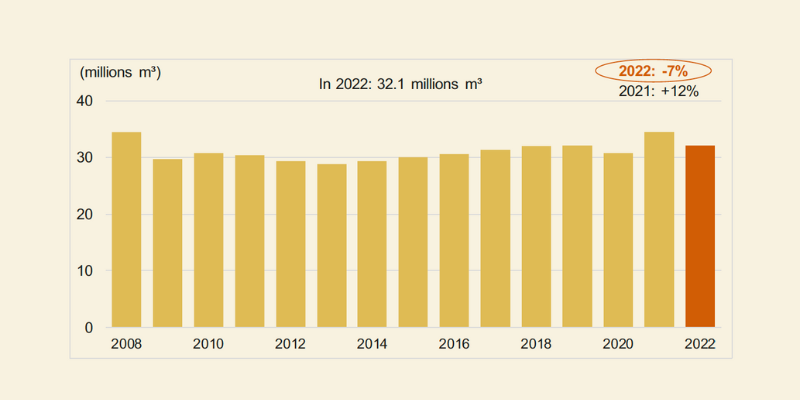
CHART 2 – Particleboard production
MDF
Mdf production in Europe decreased by 9.3 percent in 2022, down to 12.5 million cubic meters approximately, excluding Turkish and Russian production. With a production share just below 15 percent (3 million cubic meters in 2022), Germany remains Europe’s largest mdf manufacturer. The podium is completed by Poland at number two and Spain at number three, followed by France and the United Kingdom. The total production of these five countries accounted for 69 percent of European Mdf production, that was stable compared to 2021.
In 2022, 44 percent (48 percent in 2021) of European Mdf production consisted of panels thicker than 9 millimeters. Mdf panels with 5-to-9-millimeter thickness represented 27 percent (23 percent in 2021), while thin Mdf (below 5 millimeters) accounted for 29 percent.
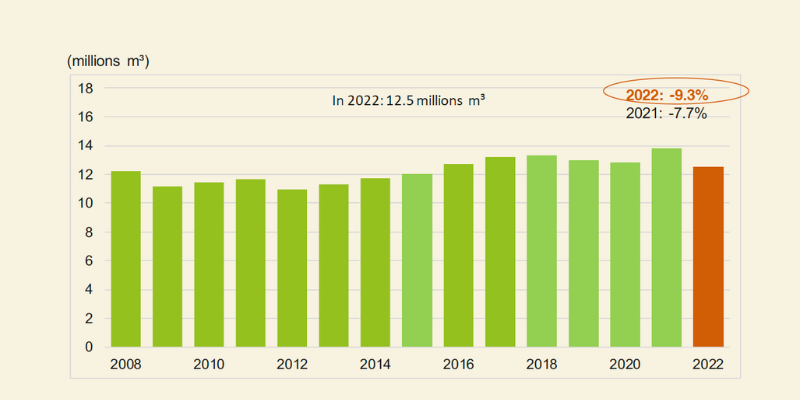
The historical ratio of raw panels and surface-processed panels is 65 to 35 percent. However, in 2022, the shares of raw mdf and laminated mdf respectively amounted to 49 and 51 percent. According to Epf estimates, European Mdf consumption decreased by 3 percent, and in 2022 it exceeded 11.6 million cubic meters, driven by economic recession. Germany maintains a dominant position.
After two years of decreasing volumes (2019 and 2020) due to the pandemic lockdown, the European mdf production capacity increased by 115 thousand square meters in 2021, mainly as a result of expansion projects in France and Poland.
Furniture was the main application for mdf in 2022, with a 51 percent share (57 percent in 2021). Also thanks to DIY, sales to the construction industry amounted to 14 percent of mdf sales (stable), just before laminate floorings with a 19 percent share (15 percent).
OSB
The European production of osb also came to a halt in 2022, decreasing by almost 11 percent (6.4 million cubic meters). Germany and Romania still have the biggest osb production capacities in Europe, with Poland joining the top-three positions after capacity expansion in 2017. Next in the ranking are the United Kingdom, the Cech Republic, Ireland and Latvia.
According to Eurostat, extra-EU export decreased by 7 percent in 2022 compared to 2021, reaching 1.32 million cubic meters. The top-five extra-Eu destinations for osb export in 2022 were the United States (397 thousand cubic meters), the United Kingdom (352 thousand), Switzerland (90 thousand), China (79 thousand), Japan (53 thousand).
The United Kingdom became the main supplier of osb to the 27-Eu (45 percent share on extra-Eu import), surpassing Russia and Belarus, whose export decreased by 54 and 68 percent respectively due to war-related sanctions.
Europe’s apparent consumption of osb decreased by 20 percent, with decreasing import (minus 1.8 percent) and increasing export (plus 11 percent) in 2022. The construction industry is the main destination of osb panels: 80 percent in 2022 (stable compared with 2021), followed by applications such as floor substrates, roofing and load-bearing applications (walls and ceilings). The rest of European osb production was absorbed by packaging (6 percent), flooring (5 percent), furniture (3 percent), DIY (2 percent) and other applications (4 percent).
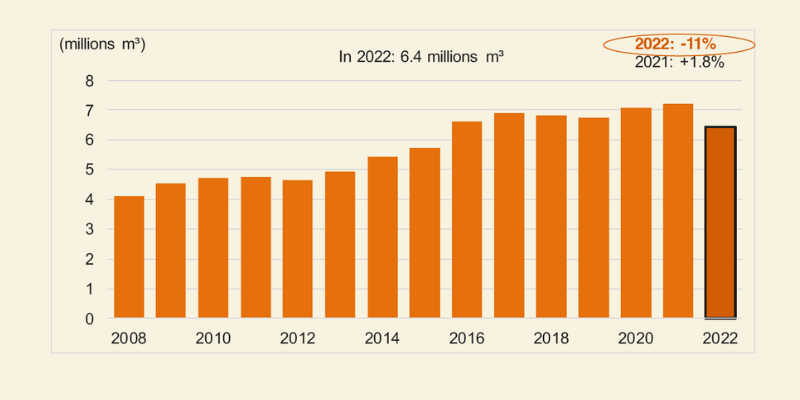
HARDBOARD
After growing slightly in 2018 and decreasing in the 2019-2020 period, hardboard production in Europe, Russia excluded, increased by 2.4 percent up to 526 thousand cubic meters. Looking at the whole of Europe, internal hardboard sales performed better than production, decreasing by one percent only. 85 percent of sales were shipped to the European Union, with a 3 percent decrease of total shipments to this region. Also global sales decreased by 4 percent compared to 2021.
The main European manufacturer is Russia (640 thousand cubic meters), whose capacity remained stable, followed by Eu leaders Poland (140 thousand cubic meters) and Bulgaria (105 thousand cubic meters). In 2022, the main application for hardboard was packaging, with a 25 percent share, stable compared to 2021. The next application is DIY, with a share falling from 20 percent of production in 2021 to 17 percent. Furniture, constructions and automotive respectively accounted for 17 percent (15 percent in 2021), 11 percent (10 percent in 2021) and 3 percent (stable).
SOFTBOARD
After falling sharply by 8,6 percent in 2019, European softboard production recorded a 5.7 increase in 2020 and 12.6 percent increase in 2021. Production exceeded 5.6 million cubic meters, breaking the all-time record of 455 thousand cubic meters reached in 2018. However, the energy crisis caused softboard production to shrink by almost 9 percent in 2022, due to increasing construction costs. Rigid softboard accounted for 60 percent (57 percent in 2021) of output and flexible softboard for the rest.
In 2022, softboard sales were mainly made up of construction materials, both rigid (37 percent versus 35 percent in 2021) and flexible (31 percent in 2022 versus 32 percent in 2021). Rigid flooring mat sales increased their share by 14 percent (13 percent in 2021), while the share of standard board on total softboard sales decreased by 6 percent. The remaining segments of high-quality rigid bitumen and other flexible panels accounted for one percent and 11 percent of 2022 sales respectively.

PLYWOOD
In conclusion, a short mention for plywood. In 2022, plywood panel production amounted to almost 3.1 million cubic meters, down by 2.5 percent from 2021. Total European plywood production recorded a stronger decrease (minus 18 percent) due to lower production in all countries (Belarus, Russia, Ukraine), except for Turkey (plus 4.8 percent) and other countries including Albania, Bosnia-Herzegovina, Montenegro, Serbia and Switzerland. Despite 28 percent shrinkage, Russia remained Europe’s top producer, with almost half of total production (46 percent), followed by Finland, Baltics, Spain, Italy, Poland and France in descending order.
The main applications of plywood in 2022 were constructions (38 percent) and furniture (27 percent), followed by transportation (13 percent) and packaging (8 percent). The remaining 14 percent (2 percent more than in 2021) was used for other applications.
Total plywood consumption followed the same trend as production, decreasing by 2.2 percent in 2022, down to 7.1 million cubic meters, driven by falling rends in the top consumer countries: United Kingdom (minus 14 percent), Germany (minus 6 percent) and France (minus 7 percent).
by Francesco Inverso
epf.org


